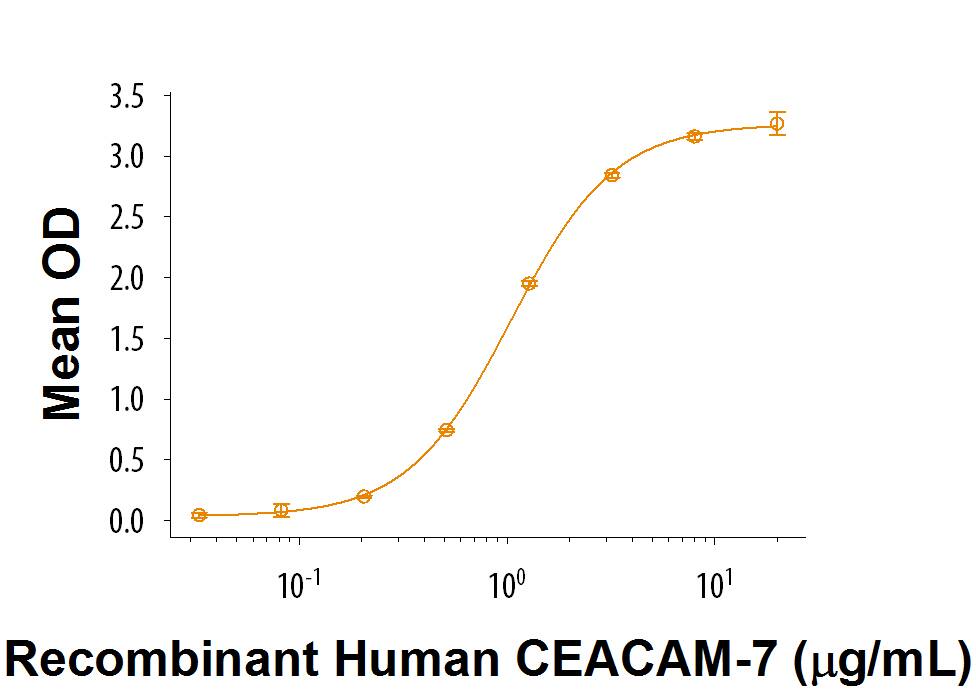Recombinant Human CEACAM-3/CD66d His-tag Protein, CF
R&D Systems, part of Bio-Techne | Catalog # 9868-CM

Key Product Details
Product Specifications
Source
Mouse myeloma cell line, NS0-derived human CEACAM-3/CD66d protein
Lys35-Gly155, with a C-terminal 6-His tag
Lys35-Gly155, with a C-terminal 6-His tag
Purity
>95%, by SDS-PAGE visualized with Silver Staining and quantitative densitometry by Coomassie® Blue Staining.
Endotoxin Level
<0.10 EU per 1 μg of the protein by the LAL method.
N-terminal Sequence Analysis
Lys35
Predicted Molecular Mass
14 kDa
SDS-PAGE
19-25 kDa, reducing conditions
Activity
Measured by its binding ability in a functional ELISA.
When Recombinant Human CEACAM‑3/CD66d is immobilized at 2 µg/mL (100 µL/well), the concentration of Recombinant Human CEACAM-7 (Catalog # 9010-CM) that produces 50% of the optimal binding response is 0.6-3.6 μg/mL.
When Recombinant Human CEACAM‑3/CD66d is immobilized at 2 µg/mL (100 µL/well), the concentration of Recombinant Human CEACAM-7 (Catalog # 9010-CM) that produces 50% of the optimal binding response is 0.6-3.6 μg/mL.
Scientific Data Images for Recombinant Human CEACAM-3/CD66d His-tag Protein, CF
Recombinant Human CEACAM-3/CD66d His-tag Protein Binding Activity
When Recombinant Human CEACAM-3/CD66d (Catalog # 9868-CM) is coated at 2 µg/mL, Recombinant Human CEACAM-7 (Catalog # 9010-CM) binds with an ED50 of 0.3-3.6 µg/mL.Recombinant Human CEACAM-3/CD66d His-tag Protein SDS-PAGE
2 μg/lane of Recombinant Human CEACAM‑3 was resolved with SDS-PAGE under reducing (R) and non-reducing (NR) conditions and visualized by Coomassie® blue staining, showing bands at 19-25 kDa.Formulation, Preparation and Storage
9868-CM
| Formulation | Lyophilized from a 0.2 μm filtered solution in PBS with Trehalose. |
| Reconstitution |
Reconstitute at 500 μg/mL in PBS.
|
| Shipping | The product is shipped at ambient temperature. Upon receipt, store it immediately at the temperature recommended below. |
| Stability & Storage |
|
Background: CEACAM-3/CD66d
References
- Beauchemin, N. et al. (1999) Exp. Cell Res. 252:243.
- Zebhauser, R. et al. (2005) Genomics 86:566.
- Schmitter, T. et al. (2004) J. Exp. Med. 199:35.
- Pavlopoulou A. and Scorilas A. 2014 Genome Biol Evol. 6(6):1314.
- Gold P and Freedman SO, (1965) J Exp Med 122:467.
- Obrink, B. (1997) Curr Opin Cell Biol 9:616.
- Horst, AK. and Wagener, C. (2004) Handb Exp Pharmacol 283.
- Kuespert K et al. (2006) Curr Opin Cell Biol. 18(5):565.
- Pils S. et al. (2008) Int. J. of Med. Micro. 298, 7–8:553.
- Nagel G. et al. (1993) Eur J Biochem 214:27.
- Skubitz KM et al. (1996) J Leukoc Biol 60:106.
Long Name
Carcinoembryonic Antigen-related Cell Adhesion Molecule 3
Alternate Names
CD66d, CGM1
Gene Symbol
CEACAM3
UniProt
Additional CEACAM-3/CD66d Products
Product Documents for Recombinant Human CEACAM-3/CD66d His-tag Protein, CF
Product Specific Notices for Recombinant Human CEACAM-3/CD66d His-tag Protein, CF
For research use only
